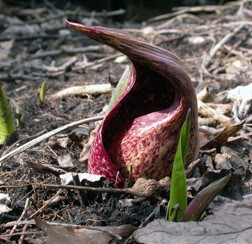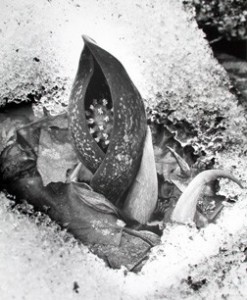Wildflower Harbinger of Spring – Skunk Cabbage
- Share
- Tweet
- Pin
- Share

The thick, fleshy spathe and single forming leaf of the Skunk Cabbage. Photo by Roy Lukes.
It was my wife who reminded me a few years ago that there is a whole new world of discovery in studying nature. A person living close to nature can never be a “know it all” because there simply is too much to be learned. That thought occurred to her as we were listening to one of our very favorite musical pieces, the New World Symphony by Dvorak, on the radio while watching an exciting bird episode in our front yard.
New discoveries along the way make even our most-simple, annual rituals memorable events. Soon we will be hiking into one of our favorite open White Cedar swamps, home of a large colony of Skunk Cabbages, the true native plant harbingers of spring. Notice I said “native” plant harbinger. Surely some ultra-early spring bulbs planted along the sunny south side of your house may beat the Skunk Cabbage to flowering.
What the Crow is to the woods and the Horned Lark to the wide open sweep of fields, so too is the Skunk Cabbage to the open Cedar swamps and marshes, moist woodlands and low stream banks. It’s the first breath of spring despite the possible snowy surroundings. All three can slough off unseasonal wintery blasts with little to no visible effects. Actually the Skunk Cabbage, with several other members of the fascinating arum family, has a built-in source of heat, as much as 22 degrees F higher than that of the air above it.
Two wild creatures, one a native to the United States and the other an import from Europe, are known to depend upon the Skunk Cabbage plants in early April. The native Black Bear, coming out of hibernation now, is said to eat the thick, long, fleshy white roots. All I can say is that the bear must possess a so-called “cast iron stomach” because the roots of this plant, like a few other members of the arum group, such as the Jack-in-the-pulpit, are rich with thousands of needle-sharp calcium oxalate crystals. I speak from experience knowing that these microscopic crystals are capable of virtually setting your mouth, tongue and esophagus on fire! The Jack-in-the-pulpit is called the “memory root” for a good reason. Once you have tasted it you’ll never forget it, nor will you ever want to taste it again!

A patch of newly emerging Skunk Cabbage and leaves. Photo by Roy Lukes.
The Honey Bee, imported to the United States from its native Europe, uncannily locates the hidden flowers of the Skunk Cabbage and consumes the pollen from its many tiny blossoms. These incredibly early bloomers beat even the willows to producing their catkins, such as Pussy Willows whose pollen is also important to the hive bees.
About the time those March doldrums are getting to you, along comes a sunny day and you set out to search for signs of spring. Suddenly you look down along the edge of the swamp and see what amounts to a circular tunnel mysteriously melted through the six-inch layer of snow and ice. Near the bottom of the tunnel is a strange, dark red, enclosed shell-like object with a gently curved, pointed tip.
The entire oddity is around four to six inches tall. You have discovered the genuine wild plant harbinger of the spring season, the Skunk Cabbage. Its scientific name is Symplocarpus foetidus. Two Greek words, “symplo” and “karpos,” refer to connected fruit, while its species name of foetidus means evil smelling.
Various references list the plant as having an odor which resembles the combination of skunk, putrid meat and garlic. Frankly the plant has never offended me nearly that much, even when I cut into one of them. It is true that its meaty color and slightly rank odor attract carrion flies, gnats and beetles, its original natural pollinators dating back many eons. Today it is invariably the imported hive bees that are the first to find the pollen of the Skunk Cabbage flowers.
A close relative of this plant, more familiar to those who enjoy the spring woodland wildflowers, is the Jack-in-the-pulpit. Jack’s pulpit is the hood-like spathe while upright Jack, the preacher, is actually the spadix. The hornlike object of the Skunk Cabbage is the spathe, fleshy, insulated with thousands of tiny air cells and quite pointed.
Colors range from yellow-green, mottled with brown, purple-red, to some that are nearly a solid deep red. Should you accidentally bruise or break off a part of the spathe you will have discovered the origin of the plant’s name. Some Southerners call it the polecat weed.

A patch of newly emerging Skunk Cabbage and leaves. Photo by Roy Lukes.
The barrel shape of the spathe traps and holds heat very well so that it actually rises into the peak, helping to melt the frozen ground or ice and snow above it. Peering into the narrow opening reveals the pale yellow spadix – like the “Jack” in the pulpit – the oblong, oval-shaped compound fruit entirely covered with over 50 tiny individual flowers, the ovaries of which are imbedded within the spongy spadix.
Dr. Albert Fuller, former curator of botany for many years at the Milwaukee Public Museum, told me that an individual Skunk Cabbage plant may live for 100 to 500 years. The thought is that the Skunk Cabbage is among the oldest of all modern-day flowering plants. It is a very unique wildflower having no other species in Wisconsin. Our species, foetidus, can be found in only two regions on the Earth’s surface, in the eastern United States and in eastern Asia, China and Japan. Of interest is the fact that a number of other plants, including the rare Ram’s-head Lady’s-slipper Orchid (which grows in Door County), American Lotus and the Tulip Tree have precisely the same distribution.
By May the leaves will have appeared like thick, light green spears piercing their way out of the swampy ground. By summer they will resemble two-to-three-foot-tall, foot-wide, heart-shaped “elephant ears” displaying a definite quilted surface texture. They are very exquisite to say the least.
Hike to the quiet swamps, more so in Southern Door County where we find them, in early April in quest of these splendid spring harbingers, the Skunk Cabbages. At the same time you are kneeling down to admire their great beauty, pinch yourself and thank your lucky star that you have entered a whole “New World” of discovery.

